Cost of Installing a Solar Water Pump System in India
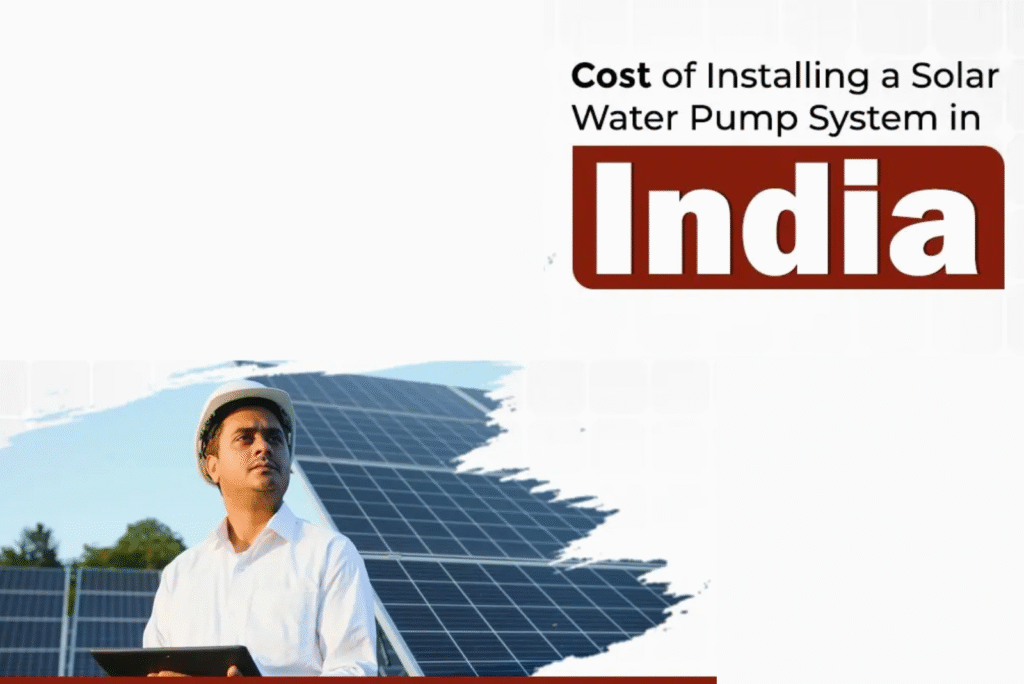
Cost of Installing a Solar Water Pump System in India Home Blogs Popular Posts All Posts Blog Seasonal Maintenance Tips for Solar… October 6, 2025 Solar Water Pump vs Regular… October 6, 2025 Rooftop Solar vs Ground-Mounted Solar October 6, 2025 Choosing the Best Solar Panel… October 6, 2025 Power Your Future with KLK Ventures Pvt. Ltd. Delivering reliable solar solutions for a sustainable tomorrow. Switch to clean energy and save with us today. Contact US Farming in India is seeing a huge shift as solar power is leading the way. The electricity costs are rising, and power cuts are still common in rural areas. This is why many farmers are turning to the solar water pump for agriculture. Why? Because it’s clean, efficient and a cost-effective way to water your fields. But the question is, what does it cost to install one? In this blog, we’ll understand solar water pump costs and subsidies. This will help you understand if solar water pumps are the right fit for the agricultural sector in India. What is the Price of a Solar Water Pump in India? Pump Capacity Approx. Price 1 HP ₹70,000 – ₹1,00,000 2 HP ₹1,30,000 – ₹1,80,000 3 HP ₹1,60,000 – ₹2,20,000 5 HP ₹2,30,000 – ₹2,90,000 10 HP ₹5,00,000 – ₹6,10,000 Factors Affecting Solar Pump Installation Cost It’s not just about purchasing a pump. The cost of installing a solar water pump for agriculture depends on a number of factors. Let’s take a look at them. 1. Pump CapacityThe size of the pump is the main deciding factor for the cost. A higher horsepower (HP) pump draws more water, which makes it great for large farms and deep water sources. A powerful pump will have a high price. For example, a 10 HP system will have a higher cost than a 1 HP pump. 2. Type of PumpThere are different types of pumps that you’ll find in the market. Submersible pumps – These pumps go under the water level and are best for borewells and deep wells. These pumps are on the expensive side due to their build and high power needs.Surface pumps – Surface pumps are installed above the ground to fetch water from shallow water sources. These pumps are more affordable than the submersible ones. Also read – Different types of solar water pumps 3. Solar Panel QualityThe solar water pump price depends on the quality of the solar panel too. There are many different types of panels with different efficiencies. The higher-quality panels’ price can be a bit high. These are more reliable and cost-effective in the long run. 4. Installation ComplexitySetting up a solar water pumping system requires labour, strong mounting structures and more wiring. All of this adds to the total cost which may affect the solar water pump price. 5. Additional ComponentsA solar water pump system isn’t just a pump and panels. It includes other parts too. Inverter – It’s needed for an AC pump which cannot use direct current.Controller – This manages the flow of current and also prevents damage.Mounting structures – These hold your solar panels in place to maintain their efficiency.Batteries – Batteries store extra energy so that the pump can work even in cases of no sunlight or at night. Each of the factors matters in making up the total cost of a solar water pump. So, it’s important to consider every aspect while making a decision. Government Subsidies for Solar Water Pumps in India The Government of India has always been first when it comes to encouraging people to take steps for the betterment of the future. Solar water pump subsidy is one method to do so. By providing excellent subsidies for installing solar water pump for agriculture, it’s becoming increasingly easier for farmers to turn to solar. Under their Pradhan Mantri Kisan Urja Suraksha evam Utthaan Mahabhiyan (PM KUSUM) scheme, the solar water pump subsidy is: Central Government Subsidy: 30% of the total cost. State Government Subsidy: 30% of the total cost. Farmer’s Contribution: The remaining 40% is borne by the farmer. (30% of which can be taken as a loan) This means solar water pumps for agriculture have become easily accessible through subsidies and low solar water pump price. Also read – Solar Kusum-B yojana & Solar Kusum-C Yojana for more information about the same. Cost Difference: AC vs. DC Solar Pumps AC Pumps – These have a lower initial pump cost. However, these solar pumps require inverters to function which adds to the installation costs. Also, due to the complex components, the maintenance needs may rise and cause a rise in the expenses. DC Pumps – These pumps have a higher upfront cost due to many components. However, unlike AC pumps, these have low maintenance and operating costs since they run on solar power without the need for a utility grid. Is a Solar Water Pump System Worth the Investment? There are many uses of solar water pumps in agriculture. But the question is whether a solar water pump for agriculture is truly worth your money. Our answer is, yes, it is. Here’s why: 1. No More High Electricity BillsAs solar panels use sunlight, your solar water pump for agriculture won’t need to rely on the electricity grid. This reduces the electricity bills to a great extent. As farmers continue using solar water pumps for agriculture, they will be saving a lot in the upcoming years. 2. A Win for the EnvironmentSolar power is wonderful for the environment. Since the sun is a natural and renewable resource, it will minimise reliance on non-renewable energy resources. Burning coal and other fuels emits greenhouse gases such as carbon dioxide into the environment. That is why going solar is an intelligent and environmentally friendly alternative! 3. Lower Running and Maintenance CostsThe amazingness of solar panels doesn’t end at just their eco-friendly and efficient attributes, there’s much more. Once farmers install these solar pumps, they’ll have to face low maintenance costs. With no fuel and fewer moving parts, the maintenance is
solar-amc-vs-one-time-service
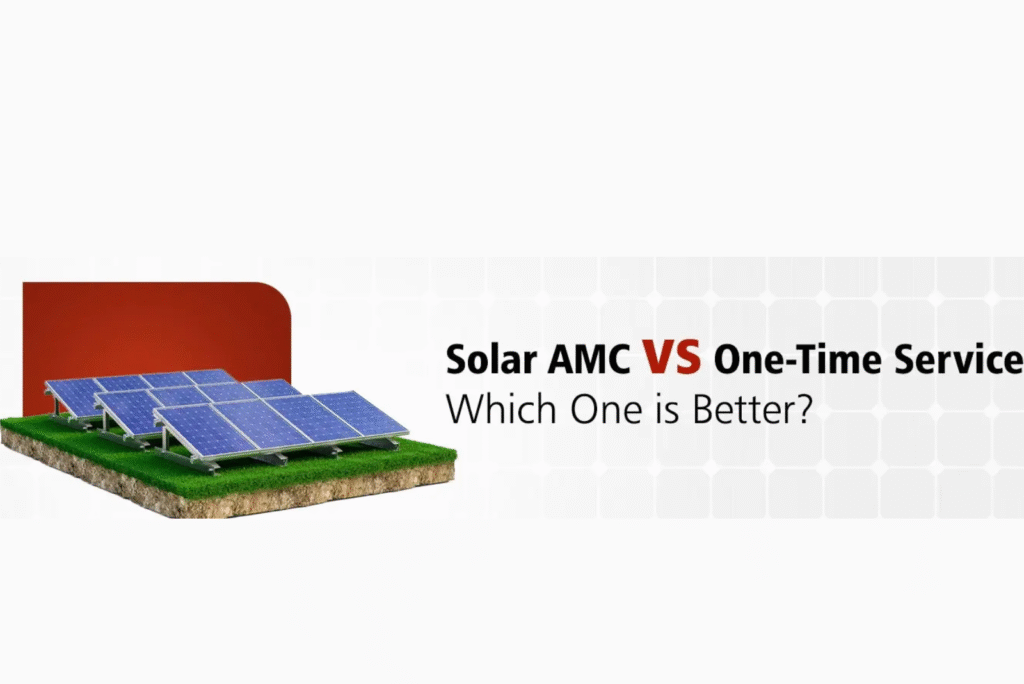
Solar AMC vs One-Time Service: Which One is Better? Home Blogs Popular Posts All Posts Blog Seasonal Maintenance Tips for Solar… October 6, 2025 Solar Water Pump vs Regular… October 6, 2025 Rooftop Solar vs Ground-Mounted Solar October 6, 2025 Choosing the Best Solar Panel… October 6, 2025 Power Your Future with KLK Ventures Pvt. Ltd. Delivering reliable solar solutions for a sustainable tomorrow. Switch to clean energy and save with us today. Contact US Going solar is one of the best things you can do for the planet and your wallet. But once those panels are up on your roof, a new question comes up: How do you keep them running smoothly for years to come? That’s where solar AMC (solar annual maintenance contracts) and one-time solar service enter the picture. Both are useful, but they have different features. So, how does one decide which one is better for them? In this blog, we’ll understand what makes one better than the other. What Is Solar AMC and How Does It Work? Solar AMC is a yearly service plan offered by solar companies upon solar panel installation. An expert team will inspect your solar system while cleaning and maintaining it if necessary. Solar annual maintenance contracts act like a reliable friend, so you can enjoy hassle-free services. Here’s how it usually works: Scheduled Inspections – Technicians visit periodically to inspect solar panels and the whole system. Cleaning – There’s a thorough cleaning of panels to remove dust or debris. This helps maintain efficiency. Performance Monitoring – The system’s energy output is monitored regularly. This is helpful because it makes sure your system is working perfectly. Repairs and Replacements – Solar annual maintenance contracts offer repair and replacement of faulty parts. Reporting – The service provider gives you reports on system performance and maintenance. That’s why Solar AMCs are necessary for large solar systems. Especially with the rise of solar technology in India, making clean energy more accessible and affordable for households and businesses. Benefits of Choosing Solar AMC for Long-Term Maintenance Most of us don’t have time (or the nerve) to climb on the roof and inspect solar panels. That’s why Solar AMC is such a game-changer. Let’s break down its wonderful benefits: 1. Hassle-Free MaintenanceSigning up for solar annual maintenance contracts means no stress. You won’t have to worry about regular clean-ups or emergency repairs any more. Your service team will take care of everything from scheduling visits to keeping your system clean. 2. Boosted Energy EfficiencyAs you’re already aware of solar panels being set up outside tend to accumulate dust on them. Dust and debris can be responsible for reducing efficiency. Solar AMC offers regular cleaning, which lets your solar panels perform their best every day! 3. Longer LifespanRoutine maintenance can add years to your system’s life. Catching corrosion early, replacing damaged wires, and tightening loose components helps a lot. With a solar annual maintenance contract, you’re adding more value to your investment. 4. No Surprise RepairsBreakdowns never come at a good time. But with solar AMC, many minor repairs are included and any big issues are caught early. This doesn’t let them turn into a financial problem later on. 5. Better Warranty ProtectionDid you know that many solar panel warranties require regular professional maintenance? Skipping checkups might void your warranty. A solar AMC helps you stay compliant without stress. Also read – Why are annual maintenance contracts important? One-Time Solar Service: Pros and Cons One-time solar service is exactly what its name suggests. Maintenance is done only when you request it. There’s no contract and you only need to pay when you need an inspection or repair service Pros: Lower upfront cost – You only pay when you actually need to check or repair your solar system. Flexibility – You can decide when and from where to get service, as you’re not bound to any contract. Cons: Less Prevention, More Reaction – With one-time services, you don’t feel the need to get your systems inspected. And if there’s no inspection, you will only know the problems when there’s some damage.Inconsistent performance – Without regular cleanings and inspections, you’ll see a decline in the performance of solar panels. Higher long-term costs – One-time services are only given when you request them. So they may go unnoticed; however, ignoring small issues will lead to bigger and costly ones. Stress and delays – If you need help, you might have to wait a long time. Finding good technicians can get a bit difficult, especially at times of emergencies. This may cause stress. Cost Comparison: AMC vs One-Time Solar Maintenance With solar AMC, you’ll pay a fixed annual fee. It includes – 2 to 4 scheduled service visits – This helps the panels stay efficient for a long time.Cleaning – Solar panels are prone to dust accumulation because they are installed out in the open. Minor repairs – These repairs or part replacements are necessary for the proper working of the panels. The costs are fixed for the services and you only need to pay the same amount. However, with one-time service, costs can vary depending on different factors. A basic cleaning might be cheap, but if your inverter fails, or your system needs rewiring? Your bill can be heavy on your pockets. It is clear that solar maintenance services like solar AMCs usually lead to long-term financial savings by keeping your system functioning effectively and preventing costly failures. Which Is Better for Residential Solar Panels? For homeowners, it’s better to choose Solar AMC. Here’s why – Life gets busy and people generally don’t have time to inspect their solar panels regularly. In such cases, Solar AMC comes to the rescue. Cleaning panels improperly can actually damage them. With the help of professionals, you’ll avoid this problem. Electrical issues can be dangerous if left unchecked. All of this requires experts who know how to deal with them properly. Scheduled inspections, regular cleanings and performance checks help keep your system up to date. How do you decide between AMC and One-Time Service for
solar-street-lights-vs-traditional-street-lights
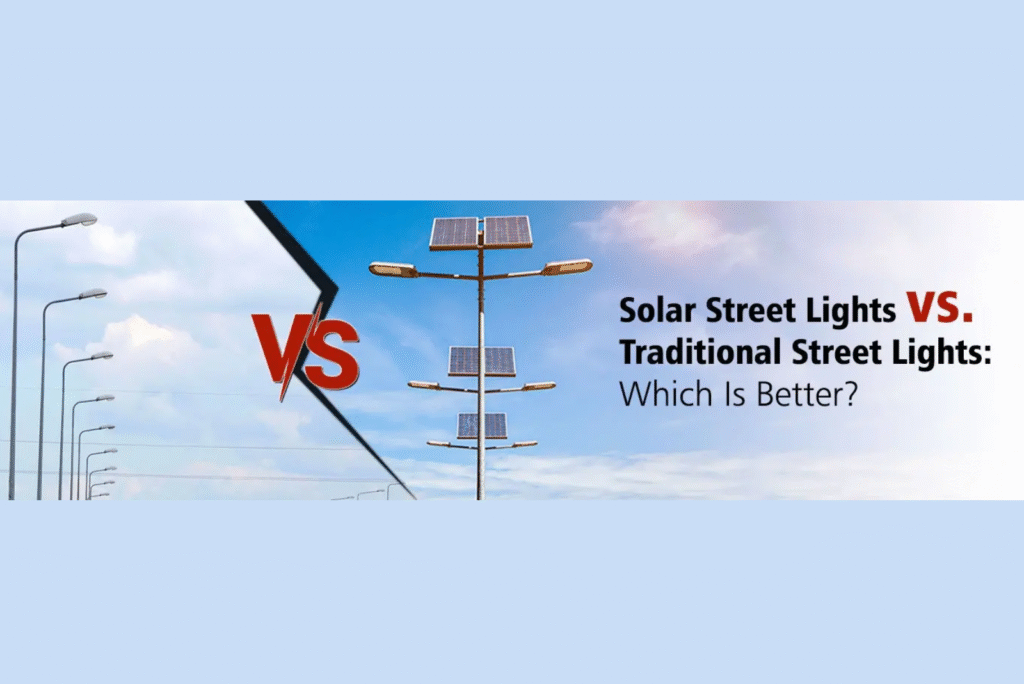
Solar Street Lights vs. Traditional Street Lights: Which Is Better? Home Blogs Popular Posts All Posts Blog Seasonal Maintenance Tips for Solar… October 6, 2025 Solar Water Pump vs Regular… October 6, 2025 Rooftop Solar vs Ground-Mounted Solar October 6, 2025 Choosing the Best Solar Panel… October 6, 2025 Power Your Future with KLK Ventures Pvt. Ltd. Delivering reliable solar solutions for a sustainable tomorrow. Switch to clean energy and save with us today. Contact US Street lights do more than just light up our roads. They make cities safer, help reduce accidents and make life after dark much easier. But as the energy prices rise and environmental concerns grow, many are turning to sustainable options. One such solution is the solar street light. It’s not only powerful but also an eco-friendly option. However, there are still some questions regarding solar street lights and traditional street lights. In this blog, we’ll understand which one provides better value and long-term benefits. How Do Solar Street Lights Work? Knowing how a solar street light works is the first step in making the right choice. Let’s see what the working process is that sets the solar lighting system apart from traditional lights. 1. Solar Panels Absorb the SunlightYou already know that without solar panels, no solar street light can function. These panels trap the sunlight to convert it into electricity. So this is why installing these panels in a place where sun rays fall in abundance is necessary. 2. Batteries Store the Energy Now, the solar panels only generate electricity during the daytime. But there’s a need for solar street lights only during dark hours, so batteries become important. These act as a power bank and store energy for use during nighttime, ensuring there’s no issue. 3. Automatic Lighting at Dusk There are built-in light sensors for solar street lights. As the sun sets, these sensors detect low light and automatically turn on the solar street light and vice versa. This feature makes them really effective and convenient. 4. Batteries Power the LED LightsThe LED lights are operated by batteries that store energy. The lights are an excellent option due to their brightness and low power usage. Homes and streets are kept well-lit by these bright lights. Cost Comparison: Solar vs. Traditional Street Lights 1. Initial Light CostSolar: Prices range from ₹4,000 to ₹13,000 (depending on features and brand).Traditional: Typically between ₹900 and ₹8,9992. Installation CostSolar: ₹7,000 – ₹15,000.Traditional: ₹5,000 – ₹10,000.3. Annual Electricity CostSolar: ₹0 (powered by solar energy).Traditional: ₹2,000 – ₹5,000 (depends on local electricity rates). Energy Efficiency of Solar Street Light When it comes to energy efficiency, Solar street lights don’t fail to impress. As these lights depend on the sun for power, there’s no issue of power supply. The solar panels do their magic during the day and absorb the sunlight to convert it into electricity. So, during the nighttime, the same energy powers the LED lights. LEDs have low energy consumption yet shine the brightest. They convert most of the energy into light. This is better than older street light technologies, which lose most of their energy. The solar lighting system has one more amazing feature: a light sensor. These sensors are responsible for switching these lights on and off automatically. This increases their efficiency to a large degree. Solar street lights also avoid the use of an electricity grid since they solely depend on the sun for power. This makes it excellent for regions where there is low grid connectivity. Maintenance Requirements: Solar vs. Electric Street Lights Maintenance is a major concern that arises when deciding between solar street lights and traditional streetlights. Individuals tend to opt for the system that needs less maintenance since it is cost-effective and saves time. With the rise of outdoor solar lighting, most individuals are changing their minds. Therefore, when it comes to street lights, what are the maintenance needs that make one superior to the other? Let’s see. Aspect Solar Street Light Traditional Street Light Wiring Needs There is no wiring required as these lights are completely off-grid and independent. Traditional street lights need underground wiring and grid connection. These wires are prone to faults and damage. Bulb Lifespan Solar street lights come with LED bulbs that are long-lasting. These last typically 10-15 years. The use of bulbs like halogen or sodium vapour raises the need to change them every few years. Cleaning Requirements The solar panels require occasional cleaning to maintain their efficiency. The fixtures may require routine cleaning. Battery Maintenance The batteries usually last 8-10 years (depending on brand and type). However, these are easy to replace. There’s no battery requirement as the power comes from the grid. Repair Complexity The solar street light only requires simple repairs. These repairs are usually limited to the unit. Traditional street light repairing is usually complex and may require rewiring. This is more time-consuming and expensive. Overall Maintenance Cost Low because of fewer replacements and no electricity bills. Higher because of regular inspections and repairs. The electricity bill is high too, based on consumption. Which Street Light Is More Environment-Friendly? Are you still wondering which street light is more environmentally friendly? Well, the solar street light takes the spot because these street lights are better in all aspects. Let’s understand how. 1. Powered by Clean, Renewable Solar EnergySolar street lights rely completely on solar energy, and you know that the sun is a renewable and green energy source. So what makes them wonderful and eco-friendly is that there’s a constant use of sunlight. Solar street lights ditch fossil fuels and other non-renewable energy sources which are often harmful to the environment. 2. Zero Carbon EmissionsThis is the greatest benefit of solar street lighting. These lights do not release carbon dioxide and other harmful greenhouse gases. The utilisation of sunlight makes these lights a green, clean source, offsetting climate change as well. 3. Increased SustainabilitySolar energy is sustainable and abundant. With the use of solar street lights in home or other areas, the
What is Green Energy?
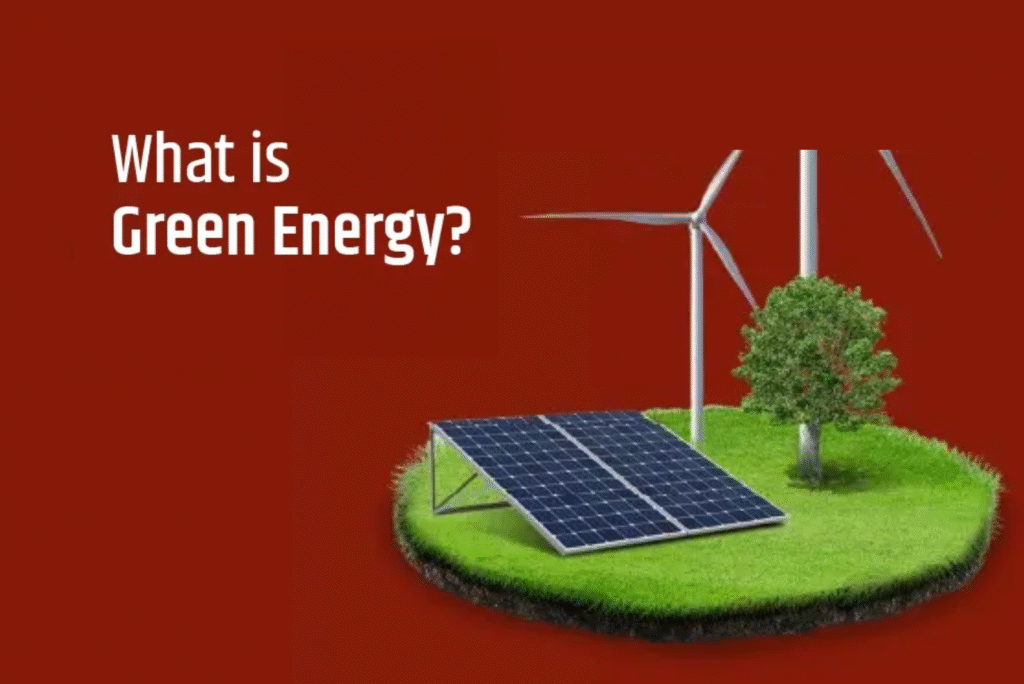
What is Green Energy? Home Blogs Popular Posts All Posts Blog Seasonal Maintenance Tips for Solar… October 6, 2025 Solar Water Pump vs Regular… October 6, 2025 Rooftop Solar vs Ground-Mounted Solar October 6, 2025 Choosing the Best Solar Panel… October 6, 2025 Power Your Future with KLK Ventures Pvt. Ltd. Delivering reliable solar solutions for a sustainable tomorrow. Switch to clean energy and save with us today. Contact US In today’s world, where environmental concerns are dominating current topics, green energy emerges as a beacon of hope. It comes from natural sources such as wind, water and sun. These green energy sources are a solution that is not only eco-friendly but also reliable. In this blog, we’ll understand green energy types and their benefits. You’ll know what makes them ideal for long-term energy solutions! Types of Green Energy Sources The amazing thing is that there are many green energy types that contribute to the betterment of the environment. Solar Energy Solar energy is the most useful form of green energy due to its availability. For as long as the sun keeps shining, we’ll get clean power. Solar panels make use of this amazing energy by converting it into heat or electricity. A better energy choice with long-term benefits! Wind Energy This green energy source is harnessed with the help of wind turbines. The turbines move to generate clean energy. Wind farms supply electricity to thousands of homes. Read more here – Can wind power and solar energy work together effectively? Hydropower Hydroelectric energy is another term for it. As the water passes through the turbines, electricity is produced. This is one of the oldest and most reliable types of renewable energy. Geothermal Energy This environmentally friendly energy source harnesses the heat that exists deep within the Earth. Both direct heating and electricity generation are possible with this heat. Biomass Energy This green energy source uses organic materials like crop waste, wood and animal waste to create fuel. Benefits of Using Green Energy There are many reasons to choose green energy. A few of them are: 1. Cleaner Air and Water Green energy production doesn’t cause any harm to the environment. There will be no release of harmful pollutants. This means using green energy sources offers a healthier and safer environment for everyone! People will get cleaner air to breathe and safer water to drink! 2. Reduced Greenhouse Gas EmissionsGreen energy types are a key to balancing climate change. You know how traditional energy sources like coal, oil and natural gas release greenhouse gases into the environment. These gases contribute a lot to the environment. So, using green energy like wind and solar helps slow down the effects of global warming. Also Read: Wind vs Solar Energy. 3. Long-term Savings The initial investment is always a bit higher but the savings will be worth it. Who doesn’t want a reduction in electricity bills and amazing savings? Once you start using green energy sources, there’s no going back. 4. Energy Access to All There are many places in India where there’s no reliable power access to date. Green energy types like wind and solar are reaching off-grid places. This will offer reliable energy access to remote places. 5. More Jobs and Local Growth This new shift to green energy is creating thousands of jobs. This renewable energy sector creates new opportunities for people. These jobs support families and local economies. How Does Green Energy Work You may be wondering how this cool and amazing energy works. Each green energy type functions differently, using different methods. Here’s how some of them work: 1. Solar EnergySolar panels are placed on rooftops or areas where there is sunlight in abundance. These panels absorb the sunlight and turn it into electricity. The electricity is then used to power homes, lights and other appliances. 2. Wind EnergyWind turbines consist of long blades that spin when the wind blows. The blades help the generator generate electricity. The electricity can then be sent to homes, businesses and even cities. 3. Hydropower Dams or rivers direct the flowing water towards turbines. The force of the water spins these turbines. The fast spinning motion is what generates electricity that powers homes and cities. 4. Geothermal EnergyHeat that is trapped under the surface is brought to the surface using pipes and wells This heat is then used to create steam. The steam spins the turbines, generating electricity. Green Energy Vs Renewable Energy There is some misunderstanding about green energy and renewable energy. Although they are not always the same, people frequently mistake them for renewable energy. Green energy is eco-friendly and renewable. This indicates that the environmental effects of this energy are small. Renewable energy sources comprise all the sources that replenish easily. However these sources also include the ones that can affect ecosystems. So, by now you might have understood that all green energy types are renewable, but not all renewable energy is green. Examples of Green Energy in Daily Life Heating and Cooling in Homes and Buildings – Green energy can be used for more than just producing electricity. Heating and cooling are two more uses for it. It is made possible by amazing innovations like solar water heaters and solar air conditioners! Transportation and Public Transit – Transportation is the fastest growing area for green energy use. Many cities have adopted electric buses and metro trains. By using renewable electricity, transportation will cause less air pollution. Agricultural Areas – Farming has seen a great change with the introduction of green energy. Solar water pumping systems have been helping the agriculture sector greatly. Farmers can irrigate fields without relying on unreliable and polluting sources. Rural and Off-grid Power Areas – Where traditional electricity is still finding a way through, green energy is taking its place. In remote areas and locations, proper grid connectivity is still a far-fetched dream. Green energy sources are improving lives in such areas. Future of Green Energy in India India is taking major steps towards a greener and cleaner future. Green
Solar Kusum-C: Benefits, Eligibility & Application Process

Solar Kusum-C: Benefits, Eligibility & Application Process Home Blogs Popular Posts All Posts Blog Seasonal Maintenance Tips for Solar… October 6, 2025 Solar Water Pump vs Regular… October 6, 2025 Rooftop Solar vs Ground-Mounted Solar October 6, 2025 Choosing the Best Solar Panel… October 6, 2025 Power Your Future with KLK Ventures Pvt. Ltd. Delivering reliable solar solutions for a sustainable tomorrow. Switch to clean energy and save with us today. Contact US The main concerns for farmers across India are unreliable power supply, high electricity and diesel costs. And the grid-connected solar pumps rely on the unreliable power supply. An unreliable power supply means delayed irrigation. However, with the Solar Kusum-C Scheme, everything becomes much easier, efficient, and sustainable. This blog will help you understand all about the Solar Kusum-C Scheme. Let’s get to know what the benefits are and how you can apply. What is the Solar Kusum-C Scheme? Like the Solar Kusum-B Yojana, the Solar Kusum-C Scheme is a component of the PM-KUSUM program. Solarizing the current water pumps is the primary goal of this component. This scheme is managed by the Ministry of New and Renewable Energy (MNRE) in partnership with state renewable energy agencies. The government of India shares the cost of solarizing the existing water pumps. This makes the solar water pumping system affordable for even small farmers. The solar water pumps are amazing as they run on sunlight and replace traditional diesel or electric pumps. The goal is to help farmers access clean energy to irrigate their farms. Solar Kusum-C Yojana also encourages the use of renewable energy resources that help both humans and the environment. Top Benefits of the Solar Kusum-C Yojana for Farmers The solar Kusum-C Yojana does much more than just offer solarized pumps. It brings tons of benefits for farmers that make farming easier, cheaper and reliable. Some of the top advantages of this scheme are: Low Electricity Bills Once the solar system is installed, farmers won’t have to worry about the rising electricity bills. As solar energy is free, the irrigation becomes almost cost-free after setup. This way farmers will save a lot of money on electricity!. No Reliance on Diesel You already know how expensive diesel actually is. And not only that, it’s also harmful to the environment. So with the help of a solar water pump, installed under Solar Kusum-C Yojana, farmers will be able to cut out diesel completely. Reliable Power Supply In remote areas, power cuts are frequent especially when farmers need water the most. Solar pumps are what help in such cases. They are a reliable source of power and can supply water whenever needed. Low Maintenance Diesel pumps are complex and come with heavy parts. So when farmers switch to solar pumps, they are bringing home machinery that is low maintenance with fewer moving parts. These pumps need very little time and money for repairs. Extra Income Opportunity Here’s something that will help farmers generate extra money: selling electricity. Yes, the solar system usually generates more energy than is required. This extra energy can be sent back to the grid. This will help farmers earn income! Who is Eligible for the Solar Kusum-C Scheme? Individual Farmers Any farmer using a grid-connected pump is eligible to apply for the PM KUSUM scheme. Water User Associates (WUAs) A group of farmers that share irrigation infrastructure can also benefit from this scheme. Farmer Producer Organisation (FPOs) FPOs that manage operations for multiple members are eligible to apply for the same too. Primary Agriculture Credit Societies (PACS) PACS operating shared irrigation systems are also eligible to apply for the Solar Kusum-C Scheme. Community or Cluster-Based Irrigation Systems The large irrigation systems that are used by the villages or farming communities also qualify for the scheme. Step-by-Step Guide to Apply for Solar Kusum-C Yojana Online Applying for this scheme is simple if you follow the right steps. Here’s how you can do it online: Go to the official PM-KUSUM portal. You’ll find the section for Component C on the main page of the portal. Click on it. Register with your basic details. Once you find the section, you can fill in the details like name, Aadhaar number, land details, pump details and contact information. Upload the required documents. Once you’ve filled out the necessary details, you’ll have to upload the documents. These usually include a copy of your Aadhaar card, land documents, passport-size photo and recent electricity bill (if any). Submit your application. After reviewing your details and documents, you can click on submit. You’ll receive a confirmation message after your form is submitted successfully. Wait for approval Officials will review your application and if it gets approved, you’ll be contacted for further instructions. Subsidy and Financial Support Under Kusum-C Scheme One of the biggest reasons to apply for this scheme is the financial support. The government provides a huge subsidy, so the farmer only pays a small part of the total cost. Here’s how the cost-sharing typically works: 60% of the cost is paid by the central and state governments together. 30% can be taken as a loan from banks or financial institutions. Farmers only need to pay 10% out of their pocket. How to Track Your Solar Kusum-C Application Status After you apply for the Solar Kusum-C Yojana, we understand your concern and eagerness. You can check your application status on the official portal you’ve applied to. You’ll need: Applicant number/Aadhaar number or Registration Id Mobile Number and other details Once you’ve gathered all the details, simply log in through the website and look for the “Track Application” or “Application Status” option. Click on it, you’ll be able to review your application status there. However, if you face any issue, you can simply call the helpline num Conclusion The Solar Kusum-C Scheme is a golden opportunity for farmers to solarize their existing pumps. This will help them switch to clean and green energy that is low-cost and reliable. Also, with the help of the right solar solutions from trusted
Solar Kusum-B Yojana: Subsidy, Cost & Installation Guide

Solar Kusum-B Yojana: Subsidy, Cost & Installation Guide Home Blogs Popular Posts All Posts Blog Seasonal Maintenance Tips for Solar… October 6, 2025 Solar Water Pump vs Regular… October 6, 2025 Rooftop Solar vs Ground-Mounted Solar October 6, 2025 Choosing the Best Solar Panel… October 6, 2025 Power Your Future with KLK Ventures Pvt. Ltd. Delivering reliable solar solutions for a sustainable tomorrow. Switch to clean energy and save with us today. Contact US Irrigation is essential for farming but for many farmers, running irrigation pumps is a daily struggle. Diesel is costly, electricity is unreliable. And if there’s a delay in water, there will be no crops. Solar Kusum-B Yojana is what helps change this. Farmers get to install solar water pumps at an affordable cost with up to 60% subsidy support. This blog will help you understand everything. Read on to learn who can apply, how much it costs, and what the installation guide is. What is Solar Kusum-B Yojana? Overview of the Scheme The Solar Kusum-B Yojana is a part of the much larger Pradhan Mantri Kisan Urja Suraksha evam Utthan Mahabhiyan (PM-KUSUM) scheme. Installing independent solar water pumping systems up to a maximum capacity of 7.5 HP is the main objective of Component B. Farmers who want to install solar-powered irrigation pumps can get financial assistance through the Solar Kusum-B Yojana. These pumps are particularly well-suited for remote locations since they run on their own. Reducing dependency on grid electricity and diesel for agricultural irrigation is the aim. Farmers are eligible for up to a 60% subsidy under this program. This will make it affordable for them to switch to a cleaner and greener energy source. Eligibility Criteria for Solar Kusum-B Yojana 2025 Individual farmers who own cultivable land. Farmer Producer Organizations (FPOs), Primary Agriculture Credit Societies (PACS), and Water User Associations (WUAs). Applicants must be in off-grid or partially electrified areas. Farmers who currently use diesel pumps are given preference. Those who are implementing micro-irrigation systems or efficient water management practices are also eligible. How to Apply for the Solar Kusum-B Scheme Online Are you looking for ways to apply for the Solar Kusum-B Yojana online? Then read on. Here’s the easy step-by-step process: Go to the official portal Visit the Kusum Component-B section of the MNRE website. Register as a beneficiary Find the option where you can fill in details like name, mobile number, Aadhar number, and land information. Upload documents You should keep the scanned copies of the necessary documents, like – Aadhaar card Photograph of the applicant Land ownership proof Address proof (ration card, voter ID, etc.) Bank passbook or account details Recent electricity bill (if applicable) Verification by the authorities Once you’ve uploaded the documents and your application is submitted, State Implementing Agencies (SIAS) will check the documents and verify them. Approval and vendor selection If the application gets approved, the names will be displayed on the portal. And after that, a registered vendor will be assigned to install the pump. Subsidy and loan disbursement The subsidy is given to the vendor directly. This reduces the installation costs for the farmers. Farmers can then pay their share through personal funds or loans. Subsidy Details and Financial Assistance Under Kusum-B The reason why many farmers are inclined towards the solar Kusum-B scheme is due to the generous subsidy structure. The government offers a great subsidy for the installation of pumps. Let’s see how it actually works. Central Government Subsidy – 30% of the pump’s cost State Government Subsidy – 30% Farmer’s Own Contribution – 10 % of the total cost Bank Financing – If there’s a need, farmers can opt for the remaining 30% as a loan Farmers living in areas like the North-East, Himalayan states (Himachal Pradesh, Uttarakhand), etc, get up to 50% central government subsidy. The financial support is what helps the farmers greatly. Through this scheme, solar irrigation is made possible even for marginal farmers. Cost Breakdown and Farmer Contribution in Kusum-B Scheme The actual cost of a solar pump varies based on its capacity and location. But to give you a rough idea of its cost, here’s a general cost breakdown: 5 HP Solar Pump SystemTotal Cost: ₹1.5 lakh Central Subsidy (30%): ₹45,000 State Subsidy (30%): ₹45,000 Farmer’s Contribution (10%): ₹15,000 Optional Loan (30%): ₹45,000 Step-by-Step Solar Pump Installation Process Under Kusum-B Online Application The farmer will need to register on the official PM-KUSUM portal and submit the required documents. Verification and Approval After all the necessary documents are submitted, the State Implementing Agency (SIA) will review the application. Vendor Assignment and Payment Once the application is approved, an authorised vendor is assigned. The farmer will pay their 10% share and complete their necessary formalities. Installation and Training The vendor installs the solar pump on-site. The farmer is then trained on how to operate the pump for better efficiency. Maintenance Services Maintenance services are mandatory for their smooth functioning even after years. Benefits of Solar Kusum-B Yojana For Farmers: Cut Down on Farming Costs – By switching to solar powered pumps, farmers will eliminate the need for diesel and grid electricity. These options are costly; however, with the help of solar power, the farming costs will be lower to a great extent. Access to Reliable Water Anytime – With different types of solar water pumps, farmers will no longer have to rely on grid electricity or fuels. They can irrigate their fields at daytime to ensure timely watering. Low Maintenance, Long-Term Use – Solar water pumps require less maintenance than diesel pumps. These pumps work efficiently for years with minimal upkeep! Boost in Crop Yield – You know what consistent and hassle-free irrigation means? Your crops get the water when needed. This leads to better crop growth, which directly boosts farmers’ income. Conclusion The Solar Kusum-B Yojana is more than just a subsidy scheme, it’s a movement that leads to sustainable and better farming. With low initial investment, long-term savings and environmental benefits. A trusted solar company, like KLK Ventures, will help farmers access the Solar
Key Differences Between Renewable and Non Renewable Energy Resources
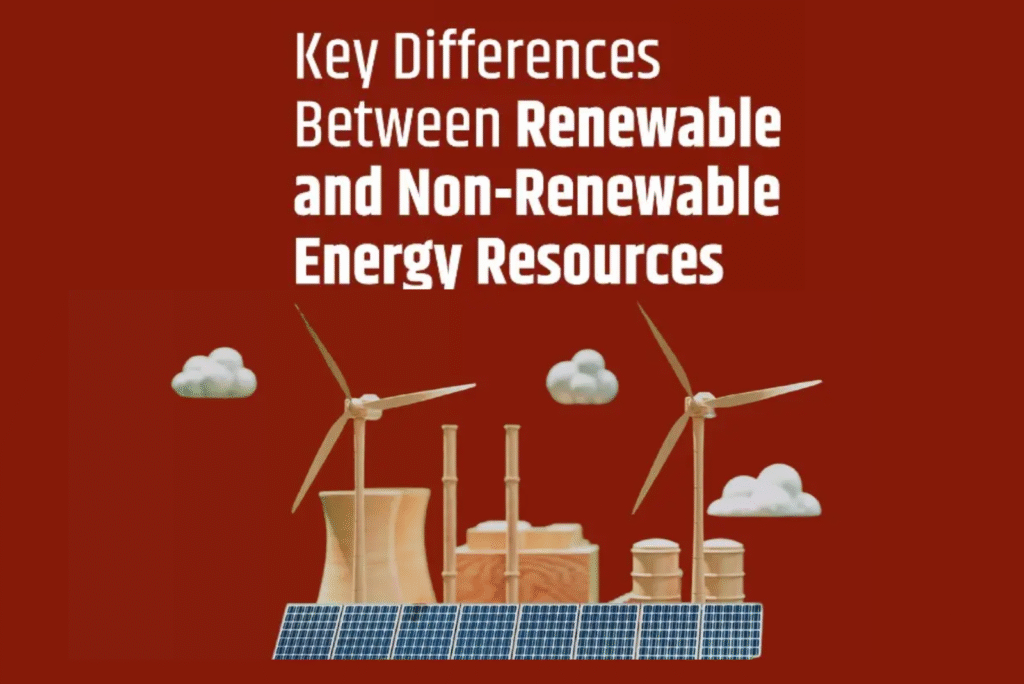
Key Differences Between Renewable and Non Renewable Energy Resources Home Blogs Popular Posts All Posts Blog Seasonal Maintenance Tips for Solar… October 6, 2025 Solar Water Pump vs Regular… October 6, 2025 Rooftop Solar vs Ground-Mounted Solar October 6, 2025 Choosing the Best Solar Panel… October 6, 2025 Power Your Future with KLK Ventures Pvt. Ltd. Delivering reliable solar solutions for a sustainable tomorrow. Switch to clean energy and save with us today. Contact US Energy fuels everything around us. Every time you charge your phone, run your fans & appliances or drive a car, you’re consuming energy. But do you stop and think where this amazing energy actually comes from? There are many sources of energy. Some are clean and endless while others are limited, slowly running out and polluting. This is why understanding the difference between renewable and non renewable energy resources becomes really important. In this blog, we’ll explore why choosing the right one matters. What are Renewable Energy Resources? Renewable energy resources are sources of energy that are naturally replenished on a human timescale. This means they don’t run out. This is the major difference between renewable and non renewable energy resources. These resources are available in abundance and are also cleaner and environmentally friendly. A great choice because you’ll find that they produce little to no greenhouse gas emissions. Which means that they are a great key to fighting climate change. Main Types of Renewable Energy Resources Solar Energy Solar energy is an important source. Solar panels and photovoltaic cells capture this amazing energy and turn it into electricity. It’s one of the most available and reliable sources of energy. Also read: Advantages and Disadvantages of Solar Energy Wind Energy Wind turbines harness the kinetic energy of air and turn it into electricity. This energy is suitable for plain areas and coastal regions where wind flow is steady. Read to know if wind power and solar energy can work together effectively Hydropower By harnessing the flow of rivers, dams and the ocean, you can generate hydropower. It’s also one of the largest sources of renewable electricity in the world. Biomass Energy This is one of the cleanest renewable energy sources as it’s often derived from organic materials. Wood, crop waste and even animal manure are used for it. What are Non Renewable Energy Resources Non-renewable energy resources are natural resources that cannot be replenished. That is to say, if you consume these resources, they might disappear forever. These resources were formed over millions of years through the slow geological processes of heat, pressure and decay. The upside is that non renewable resources have increased the growth of industries and modernisation for centuries. However, the negative thing is that at this point, their consumption might lead to their complete depletion. Main Types of Non Renewable Energy Resources Coal This is a black sedimentary rock that is rich in carbon. Coal is burned to produce heat and electricity. It’s one of the most polluting energy sources and contributes to air pollution. Oil (Petroleum) It’s a liquid fossil fuel taken from underground reservoirs. The oil is refined into gasoline, diesel and other fuels, which are heavily polluting and major contributors to global warming. Natural Gas This gas is made of methane and burns cleaner than coal and oil. However, it’s still not a clean source of energy and emits carbon. It’s often used for heating and electricity purposes. Nuclear Energy Nuclear power relies on uranium, which is a non renewable energy source. It produces radioactive waste which is harmful to the environment as well as humans. Difference Between Renewable and Non Renewable Energy Resources Characteristics Renewable Resources Non-Renewable Resources Definition Natural resources that are replenishable Natural resources that can’t be replenished within a human timescale Formation They are formed through ongoing natural processes They are formed through slow geological processes Examples Solar energy, Wind energy, Hydropower, Geothermal energy Coal, Oil, Natural Gas, Copper, Iron Environmental Impacts Minimal emissions and pollution Contributes to greenhouse gases and air & water pollution Costs Initial setup is higher with long-term cost savings Typically low upfront costs but rising long term expenses Supply Unlimited if the ecosystem remains intact Finite supply Long-term Sustainability Ideal for long-term energy goals Unsustainable in the long run Environmental Impact: Comparing Renewable and Non Renewable Energy Resources Low to No Greenhouse Gas Emissions –There is no pollution since solar panels and wind turbines harness the power of the sun and wind. With renewable energy sources, this is primarily true. They are an excellent choice because, even after extensive use, no dangerous gases or pollutants are released. You can learn more about wind vs. solar energy. Clean Air – Unlike fossil fuels, renewable energy sources don’t emit harmful pollutants into the atmosphere. You know what that implies? Less smog, cleaner air and fewer respiratory diseases. This proves to be advantageous for city life. Less Water and Land Damage – For the most part, renewable energy systems consume very little water compared to the enormous power plants using coal or natural gas. The systems tend to minimize damage to the ecosystem and also take up less land. This is particularly true in terms of rooftop solar panel installation and offshore wind farms. Sustainable by Nature – All the renewable energy sources like wind, sun and water are natural and fully replenishable. As long as the world continues to exist, you’ll find them in every corner. This makes renewable energy sustainable in the long run, something that isn’t the case with non renewable energy resources. Non-Renewable Energy High Greenhouse Gas Emissions – One of the main sources of carbon dioxide emissions is fossil fuels, particularly coal. Massive volumes of greenhouse gases are released when coal is burned for electricity, trapping heat and contributing to climate change. Air Pollution – You already know that the growing industries use non renewable energy sources to produce power. Power plants and vehicles run on oil and gas that emit toxic, air-polluting gases. These can cause serious health problems among people. Water Pollution and Waste – As the factories’ waste goes down
Can Wind Power and Solar Energy Work Together Effectively?
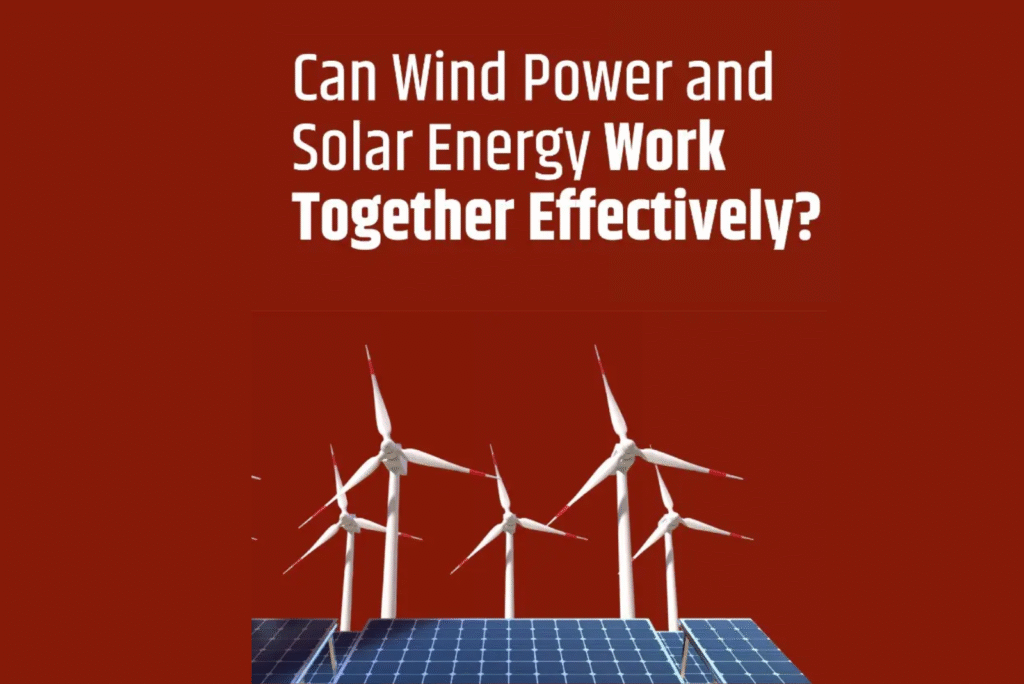
Can Wind Power and Solar Energy Work Together Effectively? Home Blogs Popular Posts All Posts Blog Seasonal Maintenance Tips for Solar… October 6, 2025 Solar Water Pump vs Regular… October 6, 2025 Rooftop Solar vs Ground-Mounted Solar October 6, 2025 Choosing the Best Solar Panel… October 6, 2025 Power Your Future with KLK Ventures Pvt. Ltd. Delivering reliable solar solutions for a sustainable tomorrow. Switch to clean energy and save with us today. Contact US Can you imagine how powerful a system that combines many renewable energy sources would be? With the world advancing in technology, it’s possible for different power sources to work together effectively. Even wind power and solar energy work efficiently when combined together. They form a hybrid power system, an efficient way to generate power. In this blog, you’ll understand the benefits and other aspects of these two amazing sources working together. Limitations of Single-Source Power System Both wind power and solar energy are amazing on their own, but there are certain challenges one might face with them. These systems alone have a few limitations that need to be addressed. 1. Solar EnergyDaytime Only – There are many reasons why solar panels are beneficial, but when it comes to energy generation 24/7, they fail. As the sun is the main source, they can function at night. This may cause issues with the power supply in case of emergencies if your system isn’t backed up with batteries. Weather Dependency – Solar panels give great energy output during sunny hours. But what happens when the weather conditions change? They stop functioning on rainy or cloudy days. Nighttime Energy Gap – When the sun sets, solar power doesn’t work. This creates a huge gap in energy supply if there’s no proper solar energy storage. 2. Wind Power Weather Reliance – Wind turbines require steady, high wind speeds to produce electricity. Yet, it’s not always going to be able to blow at high speed, so the system isn’t as efficient. Inconsistent Output – The amount of energy your wind turbines produce depends on the location and seasonal winds. Areas where there are very low wind speeds won’t get enough power supply. Long Periods of Low Power – Weather changes constantly and even areas where there’s a good speed of wind may face calm days. This causes the energy generation to be low. Both wind power and solar energy have their own gaps and limitations when it comes to generating electricity. In addition to that, single power systems can be costly and sometimes inefficient. This makes space for the need for wind power and solar energy to work together in a hybrid power system. What Is a Wind Solar Hybrid System? A wind-solar hybrid system means the best of both wind power and solar energy! This is a great renewable energy setup that is highly efficient in generating clean electricity at all times. With this system, you get the benefit of two in one. One system, either a solar power system or wind turbines, can only function at specific times of the day. But hybrid systems are designed to function during the day and night. You know that solar panels function during daylight hours while wind power tends to be strong during stormy weather or nighttime. When wind power and solar energy are combined, they generate sufficient power 24/7. Components of a Hybrid Power System Solar Panels – It includes photovoltaic panels to capture sunlight during the daytime to turn it into electricity. Wind Turbines – These are used to harness the amazing wind energy to generate power. A Charge Controller – This regulates the flow of electricity. And also protects them from overcharging. An Inverter – The inverter is one of the most important components, as it converts DC electricity into usable AC electricity. Battery Storage – This is optional, but still great for storing extra energy. This can be used when in need. Benefits of a Hybrid Power System | Combining Wind Power and Solar Energy There’s always a debate between wind vs solar energy. But do you know that using a hybrid system that combines wind power and solar energy has many advantages? Let’s look through them. 1. Continuous and Reliable Power SupplyBy combining two renewable energy sources, the system becomes even more efficient. Solar panels only work on sunny days, but wind turbines can run day or night. In this manner, the system provides a reliable power source and lowers the chance of power outages. 2. Increased Energy EfficiencyA hybrid power system maximises the use of natural resources. That is to say when it gets cloudy or rainy, wind turbines use the high wind speed to generate power. And when it’s sunny, solar panels work their magic! This system, thus, works most of the time. 3. Ideal for Remote LocationsIt’s a fact that even after continuous development, many remote areas lack the proper grid connectivity. And it’s a challenge to lay down a whole grid system there. In such cases, a hybrid power system can become really useful. Combining both wind power and solar energy will generate the required power. 4. Reduces the Need for Large Battery StorageSince there are two great energy sources working together to supply power at different times, there’s usually no need for battery banks. You won’t need to store energy as your system is constantly generating it. This further reduces the costs of installing large battery storage systems. 5. Lower Environmental Impact A hybrid system uses great renewable sources. What it implies is that there will not be any release of greenhouse gases into the atmosphere. These will enable you to keep your carbon footprint at a low level and benefit the environment to a higher standard. These systems are a means of cleaner and more sustainable energy generation. Challenges in Solar Development High Initial InvestmentWe know that solar power greatly helps save money in the long run, but the initial investment is still high. Especially for people who come from a middle-class background may see it as challenging. This
The Rise of Solar Technology in India

The Rise of Solar Technology in India Home Blogs Popular Posts All Posts Blog Seasonal Maintenance Tips for Solar… October 6, 2025 Solar Water Pump vs Regular… October 6, 2025 Rooftop Solar vs Ground-Mounted Solar October 6, 2025 Choosing the Best Solar Panel… October 6, 2025 Power Your Future with KLK Ventures Pvt. Ltd. Delivering reliable solar solutions for a sustainable tomorrow. Switch to clean energy and save with us today. Contact US As the world continues exploring renewable energy sources, solar energy still stands firm as one of the best. In countries like India, with around 300 sunny days, harnessing solar power becomes even easier. And with the help of advancing solar technology in India, everyone is looking forward to the sun as an amazing source. In this blog, we’ll explore how solar energy in India is becoming one of the most preferred choices of homeowners and businesses. We’ll also take a look at the opportunities and challenges in the solar energy sector. Potential of Solar Energy in India We already know that India is a sunny country that sees a lot of sunshine throughout the year. This is why solar technology in India has been advancing to make the most of it. In India, there’s an estimated potential of producing 5,000 trillion kilowatt-hours (kWh) of clean energy annually. The best part is that the energy that will be generated will be more than enough. The potential solar energy sector in India needs to be taken into consideration. With the right policies, infrastructure and awareness, this potential has the power to turn into an amazing reality! Why Choose Solar Energy? Before we move on to the best solar technology in India, let’s go through the reasons why one should go solar. Cost-Effective in the Long RunThe initial solar panel installation may seem a bit expensive to many, however, there’s an upside to that. Once you get your solar panels installed, it will make your electricity bills smaller and your savings bigger. Also, many Indian states offer solar panel subsidies and tax benefits. This makes solar energy in India even more affordable! Eco-Friendly and CleanSolar energy is a green and clean source of energy and it is valued for the same. In contrast to our conventional ones, such as coal and other fossil fuels, solar energy does not emit harmful greenhouse gases and pollutants. So, this option is a better way to power your homes or businesses. Energy IndependenceBefore solar technology in India was introduced, everyone was relying on a traditional electricity grid. However, this grid didn’t reach remote areas. With the amazing solar power, now rural areas and even households in urban settings can benefit from solar power. It reduces your reliance on the unreliable grid. Low MaintenanceWith the advancement in solar technology in India, modern solar panels require very minimal maintenance. The best part is that they are durable and last up to 25 years. They are reliable, clean and low maintenance. You don’t have to spend a fortune on their maintenance. Read more about why annual maintenance contracts are important. Job Creation and Local GrowthThe growing popularity of solar energy in India is creating a space for more jobs and supporting growth too. The solar energy sector in India is allowing jobs for people in the field of manufacturing, installation and maintenance. Attractive Government Subsidies and IncentivesWith amazing subsidies and incentives, the Indian government is strongly encouraging solar energy. Many initiatives like the Rooftop Solar Scheme offer up to 40% financial assistance for installing solar panels. This makes solar power affordable. Read more about – 2 kw solar panel price in India with subsidy & 1 kw solar panel in India Solar Technology in India – Types and Uses India is growing in the sector of solar energy and we can see it through the emerging solar technology in India. Solar Photovoltaic (PV) Technology Photovoltaic panels are the most common type of solar setup. This solar technology in India is famous and widely applied. You can often find these panels on rooftops or open lands to power homes, street lights and water pumps. Solar Thermal Technology There are different uses of solar technology and one of them is heating. This solar thermal technology uses sunlight to produce heat. Through this heat, you can heat up water or even generate steam that drives turbines. This technology is useful in buildings that require a constant hot water supply. Floating Solar Technology Urban areas in India are becoming crowded and land is becoming more expensive. For such cases, floating solar technology in India offers a really smart solution. Solar panels get installed on lakes, reservoirs or other water bodies. This saves land and also keeps the panels cooler while improving their efficiency. Solar Storage Systems Solar energy storage is another amazing solar technology in India that is gaining popularity. The integration of lithium-ion and other types of solar batteries helps the solar system store the excess energy for use at night or during power cuts. This makes solar power very reliable and consistent. Uses of Solar Technology in India Rooftop Solar Systems – Many homes and apartments generate electricity using rooftop solar systems. Solar Water Pumps – In India, different kinds of solar water pumps run on solar energy. Particularly in areas without a dependable power source, these pumps aid in the growth of the agriculture industry. Solar Water Heaters – This is common in hotels and hospitals for heating water. Solar Air Conditioners – The use of solar technology for air conditioning is a green and clean method. Solar air conditioners are amazing especially in the summer months. Challenges in Solar Development High Initial InvestmentWe know that solar power greatly helps save money in the long run, but the initial investment is still high. Especially for people who come from a middle-class background may see it as challenging. This often makes them hesitant to switch to solar energy. Lack of Public AwarenessPeople, especially those who live in rural areas are mostly unaware of the benefits and accessibility
Wind vs. Solar Energy: Which Renewable Energy Is Better?
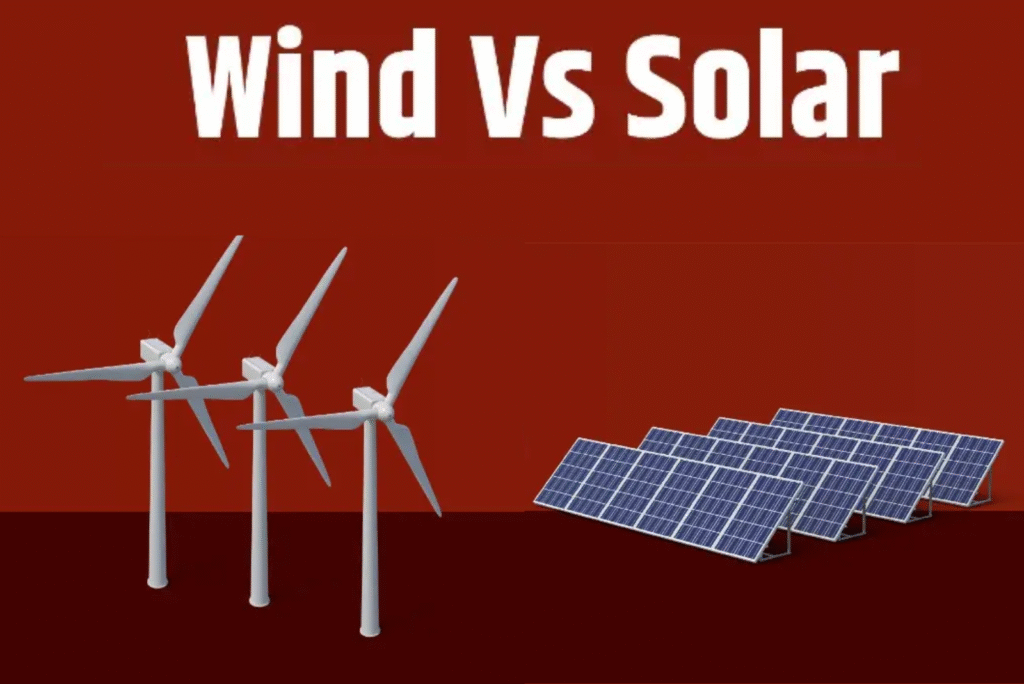
Wind vs. Solar Energy Home Blogs Popular Posts All Posts Blog Seasonal Maintenance Tips for Solar… October 6, 2025 Solar Water Pump vs Regular… October 6, 2025 Rooftop Solar vs Ground-Mounted Solar October 6, 2025 Choosing the Best Solar Panel… October 6, 2025 Power Your Future with KLK Ventures Pvt. Ltd. Delivering reliable solar solutions for a sustainable tomorrow. Switch to clean energy and save with us today. Contact US As the world continues shifting towards cleaner, greener energy, people keep looking for better options. Wind energy and solar energy are two of them. But one question keeps popping up: wind turbines or solar panels – which is the better choice? Both are amazing in their own ways. However, there are so many different factors that differentiate them from each other. In this blog, we’ll look into the pros and cons of solar power and wind power. By the end, you’ll have a clear understanding of solar power versus wind power and which one suits your needs best. Read more about 7 Renewable Sources of Energy. What is Wind Energy? Wind energy is a clean and green source of energy that is also highly efficient. Wind energy is harnessed with the help of wind turbines. The turbines’ blades move faster as the wind blows, driving the generator, which produces clean and green energy. This also requires certain technologies like generators. The electricity created through this provides power to the grid. It helps in powering homes, schools, or small businesses through the distribution of cable wires. What is solar energy? Solar energy is the cleanest and most renewable form of energy. As the name suggests, the energy is produced from the sun for the generation of heat or light energy. The Sun gives abundant and never-ending energy for maintaining an eco-friendly atmosphere. Solar panels are used for converting this energy into electricity through the use of photovoltaic cells. Wind Energy: Advantages & Limitations 1. Renewable Resource: Wind energy is a renewable source of energy. The turbines harness energy from the wind. Wind is an inexhaustible energy source and provides electricity without burning fossil fuels. 2. Generation in Remote Places: Wind Power is advantageous in those places with no connection to the electricity grid. It helps achieve significant savings in remote areas by avoiding expensive infrastructure. 3. Less Space Requirement: Wind Power does not need much space when constructed on land. The size of the blades and base is very negligible. The land can then be used for other purposes too. 4. Low Maintenance: Wind energy works for many years with very little maintenance. With more reliability and technology make the performance is higher and inexpensive. 5. Cost-effective: Wind Power is less expensive than traditional fossil fuels. It is, therefore, economical and sustainable. The affordability increases its demand and our dependence on this energy. Limitations of Wind Energy The wind turbines used for the creation of wind energy are noisy. It is mainly the noise of the blades and the generating machinery. This can affect a person if standing nearby, and also the wildlife of the surrounding areas. Wind power is also dangerous for wildlife. The birds can collide with the blades of turbines. This can be a risk to their lives. Wind Power cannot work everywhere. This is obvious because the only coastal areas, hills or fields are places where the wind is strong. Wind turbines can also be damaged in rough weather, for example, by lightning and strong winds. Solar Energy: Advantages & Limitations Here’s the general price list: 1 . Energy Independence: Solar energy is the cleanest and greenest form of energy. It is a renewable energy resource which decreases the emission of greenhouse gases in the atmosphere. It also reduces the dependence on fossil fuels. 2. Reduction in Bills: A solar energy system in your home can also reduce electricity bills. It also provides excess power which can be sent back to the utility grid. 3. Increased Home Value: Solar panel installation can also increase the value of your home. The residential rooftop system will increase a home’s resale value because it attracts buyers. 4. Low Maintenance: Investment in solar panels is also advantageous because it requires fewer maintenance costs. If kept in good condition, your solar panels will continue to provide uninterrupted service for many years. Annual solar maintenance services are the way to go. 5. Energy Saving: Solar panels get charged by the power of the sun. This charging helps save electricity through batteries. It can then be used during the night or on cloudy weather. Ultimately, it leads to more electricity production. Limitations of solar energy Solar panels are dependent on sunlight for the generation of electricity. It will not be able to work at night or in gloomy weather. If you need solar energy, your solar system needs batteries. The initial cost of installing the solar panels is not cheap. The materials required for the same are very expensive. Solar panel installation requires space. To install them, you will need a well-sized roof or place. If you want to add batteries too, the space requirement will further increase. Although solar panels do not require much maintenance, they need to be handled carefully during the process of installation process. The solar panel components are fragile and delicate. Advantages of Solar Energy Over Wind Power Predictability: When comparing wind turbines or solar panels, Solar energy is a more predictable form of energy. It also provides an increased production. Energy Production: The energy production is more through the photovoltaic cells connected in a solar power system. A series of windmills will not be able to provide this much energy. Less Noise Pollution: Solar panels do not create any noise. On the other hand, wind turbines have the constant noise of running wind turbines. Abundant Energy: The sun is a great source of energy. The electricity generation will therefore be much more than the wind energy. Low Maintenance: Solar panels require less maintenance than wind turbines. They can work effectively for around 30 years. Which is Better: Wind Turbines or Solar Panels? Wind
